The Samsung Galaxy S6 and S6 edge Review
by Joshua Ho on April 17, 2015 9:00 AM EST- Posted in
- Smartphones
- Samsung
- Mobile
- Galaxy S6
- Galaxy S6 Edge
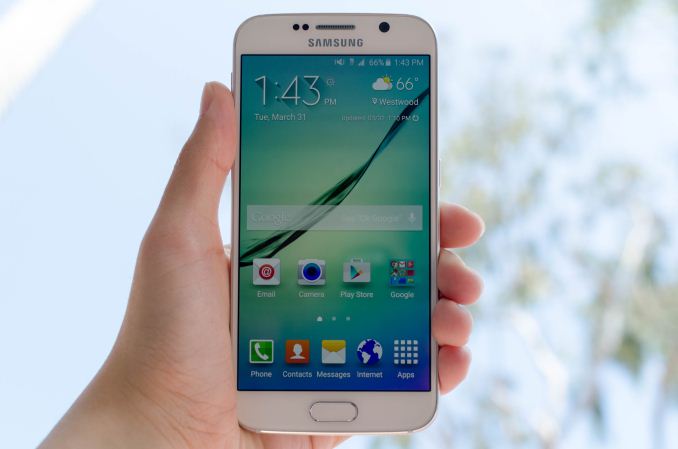
As recently as the Galaxy S5, Samsung had a fundamentally different strategy from companies like HTC and Apple. While design wasn’t ignored completely, Samsung Mobile had a different set of priorities. In general, it felt like Samsung wanted the phone to have every feature possible to please every possible potential customer. Features like a removable battery and microSD card slot seemed to be a crucial point of differentiation. TouchWiz focused on delivering a full suite of applications even if they were pretty much redundant when compared to Google’s applications. Samsung also seemed to cost-optimize their external shells, favoring polymer builds over glass or aluminum. Since the Galaxy S, this strategy paid off handsomely. With the help of strong marketing, Samsung proceeded to dominate the Android market from the days of the Galaxy S2, to the point that almost no other Android OEM was relevant in terms of market share.
However, Samsung’s tried and true strategy failed with the Galaxy S5. Fundamentally, Samsung had always been competing with Apple and their iPhone line-up at the high end, but Samsung consistently held a price advantage. The real problem was the rise of low-cost flagship phones, which squeezed Samsung significantly. Other OEMs were able to justify their high-end pricing by delivering a polished software experience and premium hardware design. In comparison to these relatively cheap phones which delivered largely the same experience and hardware, Samsung’s sales crumbled and the Galaxy S5 didn’t meet sales expectations.
This brings us to the Galaxy S6, which is supposed to be Samsung’s attempt at refocusing their product design and lineup. Design has become a major priority, and the Galaxy S6 is a radical departure from previous design in terms of almost every design choice. The Galaxy S6 represents the best that Samsung can make to some extent, as a great deal of the phone is composed of Samsung-made parts to achieve maximum vertical integration as seen in the specs below.
| Samsung Galaxy S5 | Samsung Galaxy S6 | Samsung Galaxy S6 Edge | |
| SoC | MSM8974ACv3 2.45 GHz Snapdragon 801 | Exynos 7420 2.1/1.5GHz A57/A53 | Exynos 7420 2.1/1.5GHz A57/A53 |
| RAM | 2GB LPDDR3 | 3GB LPDDR4-1552 | 3GB LPDDR4-1552 |
| NAND | 16/32GB NAND + microSD | 32/64/128GB NAND | 32/64/128GB NAND |
| Display | 5.1” 1080p SAMOLED HD |
5.1” 1440p SAMOLED |
5.1” 1440p SAMOLED, Dual Edge |
| Network | 2G / 3G / 4G LTE (Qualcomm MDM9x25 UE Category 4 LTE) | 2G / 3G / 4G LTE (Category 6 LTE) | 2G / 3G / 4G LTE (Category 6 LTE) |
| Dimensions | 142 x 72.5 x 8.1 mm, 145 grams | 143.4 x 70.5 x 6.8mm max, 138 grams | 142.1 x 70.1 x 7.0mm max, 132 grams |
| Camera | 16MP (5132 x 2988) Rear Facing with 1.12 µm pixels, 1/2.6" CMOS size, 31 mm (35mm effective), f/2.2 | 16MP (5132 x 2988) Rear Facing w/ OIS, f/1.9, object tracking AF | 16MP (5132 x 2988) Rear Facing w/ OIS, f/1.9, object tracking AF |
| 2MP Front Facing | 5MP Front Facing, f/1.9 | 5MP Front Facing, f/1.9 | |
| Battery | 2800 mAh (10.78 Whr) | 2550 mAh (9.81 Whr) | 2600 mAh (10.01 Whr) |
| OS | Android 4.4 w/TouchWiz |
Android 5 (64-bit) w/TouchWiz | Android 5 (64-bit) w/TouchWiz |
| Connectivity | 802.11a/b/g/n/ac 2x2 + BT 4.0 (BCM4354), USB3.0, GPS/GNSS, MHL, DLNA, NFC |
2x2 802.11a/b/g/n/ac + BT 4.1 (BCM4358), USB2.0, GPS/GNSS, NFC |
2x2 802.11a/b/g/n/ac + BT 4.1 (BCM4358), USB2.0, GPS/GNSS, NFC |
| Wireless Charging | N/A | WPC 1.1 (4.6W) & PMA 1.0 (4.2W) |
WPC 1.1 (4.6W) & PMA 1.0 (4.2W) |
| Fingerprint Sensor | Swipe | Touch | Touch |
| SIM Size | MicroSIM | NanoSIM |
NanoSIM |
Design
There’s a lot of ground to cover in the Galaxy S6 and S6 edge, but probably the most immediate change is to the design. The Galaxy S6 is a unibody design, with no apparent screws. This does mean that there’s no removable battery or microSD slot, which shouldn’t be a problem for most people although this may be enough for some to write off this phone completely.
The back cover is now glass instead of plastic, and is attached to the phone with glue instead of plastic latches. Regardless of color or model, Samsung has placed an extremely fine pattern beneath the glass that manages to be subtle but also surprisingly brilliant under direct light. It’s tasteful in a way that the Galaxy S5 and Note 4 weren’t. The back of the phone also has a single LED flash, a heart rate monitor, and the camera which bulges out significantly. I personally don’t have a problem with camera humps, but the Galaxy S6’s camera hump is probably the biggest I’ve seen in recent memory.
The glass back cover meets the metal frame of the phone, which provides most of the structural rigidity and strength. On the normal Galaxy S6, this frame has a very slight curve and is almost cylindrical along the top and bottom of the phone, but flattens out along the sides for better grip. The bottom of this frame has the speaker, microUSB port, and 3.5mm headphone jack, which does make for some resemblance with Apple products launched within the last year. At any rate, the placement of the speaker, USB port, and 3.5mm jack are all appropriate for a phone.
The left side of the frame contains the volume buttons, which are clicky and solid, although pressing the buttons off-center does produce a noticeable flex. The right side of the frame has the power button and the nanoSIM slot on the normal version.
On the edge variant, the sides of the frame are dramatically thinner and appear to be angled out when compared to the Galaxy S6. In the hand, this makes it feel much thinner than the S6, but it really feels almost too thin to hold comfortably. Combined with the flat back, it’s really a bit of a struggle to pick up the edge off of a table, which compromises usability when compared to the normal S6.
The top of the frame contains the IR LED for TV capabilities and a hole for a microphone. On the edge variant, the nanoSIM slot is relocated to the top of the phone.
The front of the phone is probably the only aspect of the design that feels relatively similar to the Galaxy S5. However, the texture of the bezel beneath the glass is similar to the subtle finish of the back cover, which makes for a unique visual effect that manages to be tasteful and quite unique. Other than this, we see the same layout as most Galaxy phones, with two capacitive buttons (multitasking on the left, back button on the right) and a physical home button. In the case of the Galaxy S6, this home button has been turned into a fingerprint scanner that is touch-based rather than a swipe sensor. Along the top of the front face, we also see the ambient light sensor, a proximity sensor, the earpiece, and the 5MP front-facing camera. Directly below these items is the display driver beneath the bezel, which is similar to the “logo bar” of the One M7, M8, and every other phone on the market today. On the S6 edge, the sides of the display are curved to reduce the width of the phone, which does make it easier to hold in the hand, but there’s really no bezel reduction here as the side bezels seem to be larger than what we see on the S6.
Overall, the design of the Galaxy S6 and S6 edge is really unlike anything else they’ve produced in recent memory. The phone itself is well-sized and feels much more ergonomic than the Galaxy S5 due to the thinner build and mildly reduced bezel size. It really feels like Samsung cared about the design of the phone this generation, and the attention to detail here immediately puts Samsung near the top in this area. The front of the phone still feels a bit derivative, but I suspect that there isn’t much Samsung can do to change this when faced with design constraints like a physical home button. The S6 edge does look better in some ways, but ergonomically the sharper and thinner edge is a compromise compared to the normal S6. Either phone is still easily one of the best-designed phones I’ve seen this year.


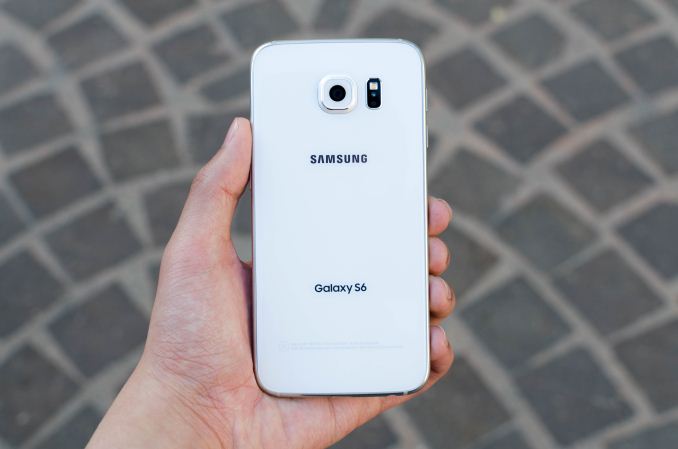
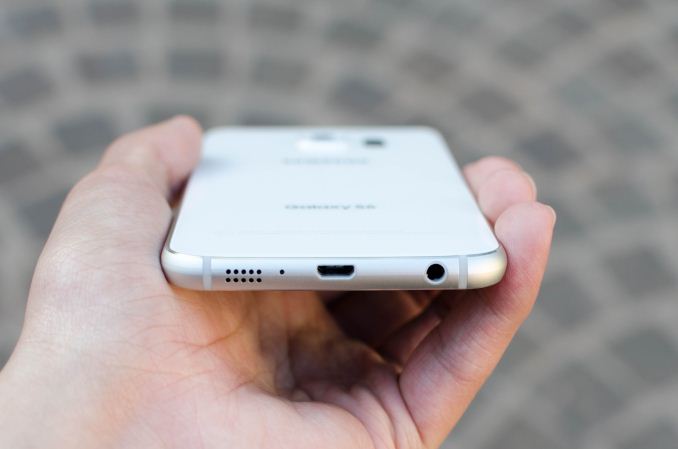
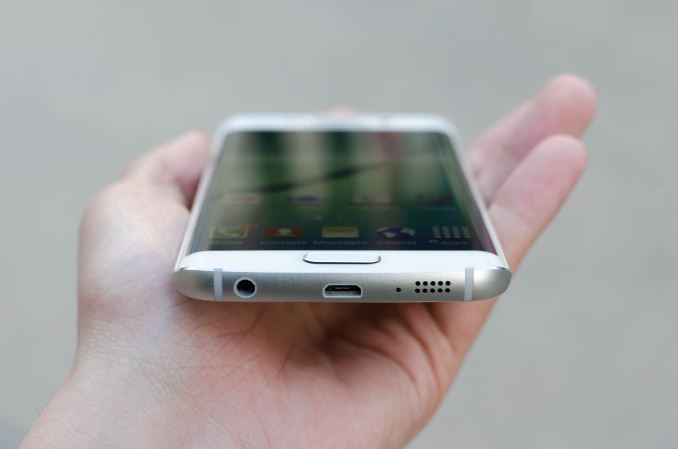



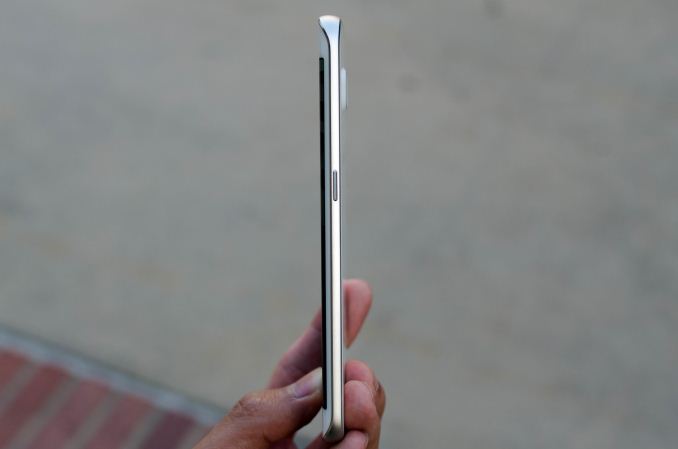

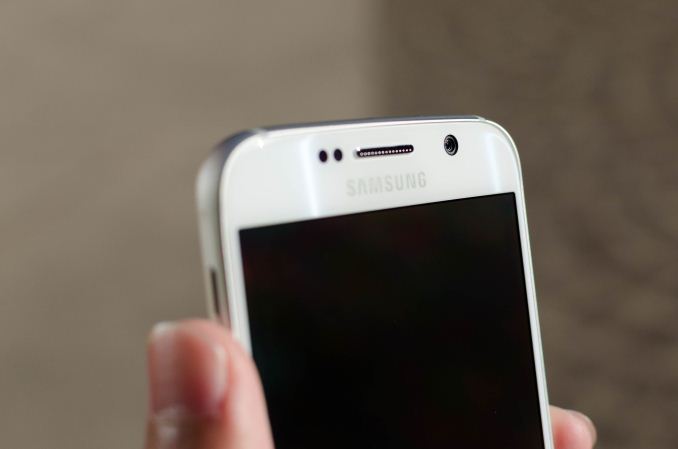
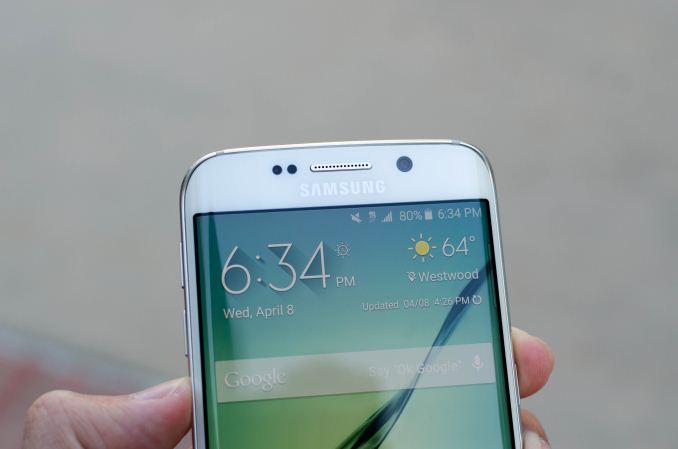








306 Comments
View All Comments
Andrei Frumusanu - Friday, April 17, 2015 - link
Math is hard, corrected, thank you.Arbie - Friday, April 17, 2015 - link
SD Police here: no microSD, no sale. The reasons have been hashed over endlessly but I know what I want.mayankleoboy1 - Friday, April 17, 2015 - link
Im very puzzled by the large differences between the stock browser and Chrome. They both are based on the Blink engine, and use V8 for JavaScript execution.This definitely points to "optimizations" done in the stock browser for these benchmarks.
Could you do some other benchmarks on the phones?
JoshHo - Friday, April 17, 2015 - link
Basemark OS II and PCMark use the internal WebView engine and the 7420 doesn't do nearly as poorly in those browsing benchmarks as it does on Chrome.It's likely that Samsung Mobile has some work to do when it comes to optimizing against Chrome.
lilmoe - Saturday, April 18, 2015 - link
Or, it's the other way around. Google needs to do a LOT of work of optimizing Chrome for the various hardware out there, especially the most popular ones.Chrome isn't getting the highest marks in optimization you know, especially on the desktop. I thought that was a well known and understood issue?
Bob-o - Saturday, April 18, 2015 - link
Can someone explain to me why an application needs to be optimized for certain hardware? Isn't it just using libraries for rendering (OGL, whatever), and those libs have already been optimized for the GPU? And the non-rendering part of the app should be byte-compiled appropriately?Back in the 1980's I used to optimize apps for certain hardware. . . in assembly code. What are they doing these days? And why is it necessary? Poor abstractions?
mayankleoboy1 - Sunday, April 19, 2015 - link
These optimizations are not for specific hardware, but for the specific BENCHMARK. They can easily tweak parameters inside the Javascript engine to give higher score on specific benchmarks like Octane and Kraken. These optimizations would negatively affect the common web JS workloads, but would give higher benchmark score.Google/Mozilla wouldnt do such shenanigans as they do not priortize for specific benchmark, unless it also improves general JS workloads
bji - Friday, April 17, 2015 - link
I have a big problem with the way their camera module juts out from the back of the device. I have a Galaxy S5 Active (my first smart phone) and the camera broke within about 2 months of ownership. I believe it's because it juts out and is a focal point of stresses as a result (pressure while in pocket, pressure when laid on a flat surface, etc), and the very weak glass they use to cover the lense is subject to breaking. I've read many comments from others that this happened to them, and it happened to me. Now the camera is useless.I could put a big ugly case on the thing to protect the camera, sure, but that's why I bought the Active - because I didn't want to put a case on my phone.
I see that Samsung continues with this horrid camera module design. I won't be buying another Samsung with this characteristic.
name99 - Friday, April 17, 2015 - link
I suspect Samsung would do well to copy Apple in one more respect --- making cases a big part of the user experience.Something that critics of the iPhone 6 (in particular the "slippery sides" and "too much sacrificed for thinness" don't seem to get is that, IMHO, Apple sees cases as a significant part of the iPhone experience. Which is why they provide their own --- expensive but very nice --- high end cases, and are willing to accept the inevitable leaks we see from case makers in advance of new products.
Once you accept that a case is part of the story
- the thinness makes more sense, because you're going to be adding a few mm via the case
- likewise the camera bulge, while less than ideal, is not such a big issue
- likewise complaints about the fragility of glass backs, etc.
Cases also allow for a dramatic level of customization without Apple having to stock a zillion SKUs. You could even argue that the aWatch band proliferation is Apple having learned from the size of the case market for iPhones and iPads, and arranging things so that they get the bulk of the high-end money that's available in this space.
Every other phone manufacturer is in a much weaker position than Apple because they don't have the massive range of cases available. But they could at least try to improve the situation by providing their own cases --- maybe at least a high end leather model, a low-end plastic model, and an "I'm paranoid I'm going to drop my phone" model. They should also call out the cases during the big press reveal of each phone (like Apple does) and ship some cases along with each review unit (not sure if Apple does this, but they should).
All of which makes the Edge, IMHO, even more of a gimmick (in spite of Samsung claiming they will no longer do gimmicks). You get a much more expensive manufacturing process to provide something whose real functionality could probably be provided with a few colored LEDs, and you dramatically reduce the design space available for cases.
Oh well. Stay tuned for the next Samsung model which (don't tell me, let me guess) will feature as its big new feature a haptic (don't call it Taptic!) engine and which, with any luck, will manage to ship in at least one country before the iPhone 6S, so that Samsung can claim (and have the true believers accept) that this was their plan all along, that they were in no way influenced by Apple's obvious [based on aWatch and MacBook] next big UI element.
akdj - Sunday, April 26, 2015 - link
Hi name99. Wish there was an up vote;). Well said. As an owner of the iPhone 6+ (& each iteration before it), I've 'finally' found the Apple iPhone case:). Lol. I bought some Platinum Incipio Pro kickstand crap, a really lame Spec case (& I love their laptop shells on my MBP) before I finally made a trip down to the Apple Store and picked up the simple, brown leather iPhone 'Apple' case (I don't remember it being expensive though, seems like 39, maybe 49 bucks? Seems like the standard pricing regardless of manufacturer out of the gate).I'm embarrassed to say since 2007, I've never had the Apple case. Always bought third party and typically Mophies starting with the iPhone 4/4s.
Sorry, TL/dr -- not in defense of Android OEM lack of third party peripherals as its true but this last year, 18 months has changed some. The S-View case specific to the 's' and 'note' brands are pretty sweet. I use one on my Note 4 and like the Apple cam/case combo the S-Case also protects the camera protrusion while adding even more functionality. It's magnet sensing for turn on/off by open/close and the small maybe 2" x 2" 'S-View' (small window on front) allows answering of calls, quick text/tweet/FB/email/whatever-u-set-up response capability, notifications and time (customize faces and information on clock), weather and 'maps', settings, and more. It's slick and it's protective.
But you're right. The Apple iOS cases kick ass. I own the 'smart' cases (not covers, they suck) on our iPads too. Be nice if they quit changing the dimensions ever so slightly each iteration ala iPhone. Usually get two generations of the iPhone outta one case. Single on an iPad. Oh well. Keep em longer too I suppose).
Good to see another avid iOS user. I love both and have since the original 4GB, non subsidized $500 2G iPhone and the Xoom/S1 ...and to date I'm undecided. Don't play with the new Amdroids. They're very nice as well. It's too dangerous now with AT&T/Verizon, even Best Buy, etc. just pick what you want. The color. The capacity. No money down and NEXT fools ya. Before you know it, you've got iPads for everyone in the family. A pair of Nexus 7s you're trying to figure out what to do with, iPhones and Notes... Just 'try' the M9, or the G3/(4 coming?) what the heck, can't hurt. Before you know it you've got a dozen devices all accessing your data, exponentially increases bandwidth used on wifi and LTE for updates and the ilk. And a $700 'phone' bill. Lol. Too cool.
Does t matter which way you go, iPhone 5s/6/6+ or S5/Note4/G3/M8 or 9, Note 4 or this bad boy. They're ALL 'computers' in our pocket. Across the board faster and more energy efficient than computers we used last decade. The storage. The connectivity. The processing and RAM, controllers (micro); accelerometer, barometer, proximity and Bluetooth 4.1, wireless AC and 2x2 antenna arrangement ...without... An antenna ( those of us in our forties, probably mid to late thirties remember those, right? ...other than the sweet 'bands' on my 6+;) course hidden by earlier do dissed Apple's iPhone case. iPad cases. They're sweet. Kinda like their trackpads in comparison to EVERY other OEM. They work. All. The. Time. They NEVER don't. WTH can't Windows get an OEM partner to nail the trackpad? Perhaps that's why they decided on 'touch'? :-)